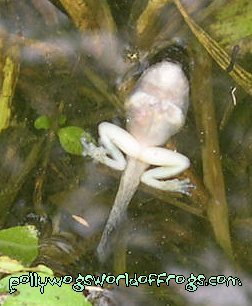Frog Health∼RX Care
 First and foremost, if you suspect your frog(s) may have any of the
bacterial, viral or fungal infections listed on this page; wear gloves, stay away
from healthy vivariums, (have another person feed your healthy frogs right now)
wash hands between every frog pickup, and properly dispose of gloves when
moving from tank to tank! Sterilize everything you and sick animal touched.
First and foremost, if you suspect your frog(s) may have any of the
bacterial, viral or fungal infections listed on this page; wear gloves, stay away
from healthy vivariums, (have another person feed your healthy frogs right now)
wash hands between every frog pickup, and properly dispose of gloves when
moving from tank to tank! Sterilize everything you and sick animal touched.
Most of the diseases listed below can jump from one type of animal to the next, such as amphibian to mammal so contamination from your frog can possibly harm YOU. Another reason to strictly adhere to the sanitizing routines.
 Be very sure that you know what your frog has before you treat it. Read through
the symptoms carefully. Never over-treat your frogs, or under-treat once you've started,
(you can potentially strengthen the pathogen). If you are not sure what your frog has, (make sure he's already in a quarantine tank)
try saving some frog poop and having your Vet examine for more precise information.
Use gloves when collecting the poop too!
Be very sure that you know what your frog has before you treat it. Read through
the symptoms carefully. Never over-treat your frogs, or under-treat once you've started,
(you can potentially strengthen the pathogen). If you are not sure what your frog has, (make sure he's already in a quarantine tank)
try saving some frog poop and having your Vet examine for more precise information.
Use gloves when collecting the poop too!
For a list of symptoms to read through first, Click here to visit the Site Search page symptoms list.
Secondly, I in no way am claiming to "cure" your frog. Many of the bacterial and fungal diseases out there today killing frogs are only now being discovered and treatments are in their research stages. Most of the methods described below I have personally used, and have worked to actually cure the frog. Others are gleaned from hundreds of hours of reading, study and actual lab work I do myself. (Yes, I do have a microscope and plate-books) I am not a doctor, but an enthusiast like many of yourselves, who has spent many years droning over ways to help my pets. (Try finding a vet who actually does work on frogs-not easy)
You will also need a Hospital tank.
Prevention
The best course of action when dealing with frogs and toads is prevention. That means keeping a spotless vivarium with good air circulation, lighting, proper temperature, hygrometer readings and clean, clear treated water. Remove any dying or rotting plant material and any uneaten food within 2 hours of its' non-acceptance. Dead or unwanted insects that are allowed to stay in tank create anaerobic dead "spots" in the tank. The same goes for rotting plant fiber. Bacteria and fungus find these items tasty and begin to multiply, threatening your frogs' health. Use false bottoms in all vivariums!

![]() Occassionally, a mushroom or two may spring up in one's vivarium. These are okay to leave in until they begin to wilt slightly. If it becomes a repeating problem, and same type of mushroom,
they've left spores in the substrate. Changing the substrate should stop this from recurring.
Occassionally, a mushroom or two may spring up in one's vivarium. These are okay to leave in until they begin to wilt slightly. If it becomes a repeating problem, and same type of mushroom,
they've left spores in the substrate. Changing the substrate should stop this from recurring.
Smell your vivarium daily. It should always have a rich earthy/mossy smell. If it has a rotten or sulfurous odor, check into what's causing the problem and remedy right away. Spray Quat regularly. Once monthly, completely clean the floor/substrate and plants of the vivarium. If no filter on water source, change daily with clean, treated water, after scrubbing the water container clean of any slime build-up. If you have a sponge-type filter on the water, change the water three times weekly. Doing these few things each day will go a long way in insuring the thriving health of froggy.
It's your choice when choosing water conditioners, but I personally swear by NovAqua and Amquel− Use them together! Using other brands haven't gotten me anything but trouble...whatever you do, stay away from any water conditioner that contains a slime coat chemical− frogs don't need this− it may suffocate them !
Medication measurements
To view a table on some of the more commonly used medication measurements, Click Here.
Boost your Frogs' Immune System
 Lately I have been reading over some information in Queensland, Australia. The Scientists
there have found that insecticides (even at low levels) are weakening the adult frogs'
systems. This is allowing all kinds of fungal and bacterial agents to get into the frogs'
body. It's happening here too...I'm sure if you've been keeping up with anything 'froggy',
that over the past few years, our northern states have been dealing with tadpole deformities.
These are also being attributed to insecticidal pollutants.
Lately I have been reading over some information in Queensland, Australia. The Scientists
there have found that insecticides (even at low levels) are weakening the adult frogs'
systems. This is allowing all kinds of fungal and bacterial agents to get into the frogs'
body. It's happening here too...I'm sure if you've been keeping up with anything 'froggy',
that over the past few years, our northern states have been dealing with tadpole deformities.
These are also being attributed to insecticidal pollutants.
My point to you? Boost up your frog's immunities! Doing this right now can help prevent you having to re-visit this page for a cure! Even if your frog is born in captivity, it is not a bad idea to give him the extra strength to ward off possible invaders.
Thankfully,  a group of Scientists in the
Ecuadorian
rainforests have noticed that a bath containing the extracted juice from the plant/vine
Cat's Claw have helped in building up the blood system of frogs.
a group of Scientists in the
Ecuadorian
rainforests have noticed that a bath containing the extracted juice from the plant/vine
Cat's Claw have helped in building up the blood system of frogs.
Cat's Claw extract can be found in Health Food stores. Make sure it is the alcohol-free version (alcohol is added to many extracts as a preservative). This treatment can be applied to the healthy frog(s) right in their vivariums. Use 1 drop of the Cat's Claw extract to each 1 ounce of distilled water. With a plastic eyedropper, place one drop onto each frogs' dorsum once a day for 6 to 8 days. You can repeat this treatment every 6 months if you'd like.
Heat Treatment
 The absolute best heating treatment you can use is simple
as well. Herp supply shops sell thin plastic-covered "pads"
that put out heat for cold-blooded animals that need constant
temperatures. These pads are placed underneath the tank, and
come in various sizes to apply to the different sizes of tanks. Use one of these
pads underneath the Hospital tank to produce the proper temperature in tank needed
for Heat Treatment. Don't use Human-style heating pads!
They have a higher heating thermostat than the herp pads. We want to only warm froggy, not cook him until tender.
The absolute best heating treatment you can use is simple
as well. Herp supply shops sell thin plastic-covered "pads"
that put out heat for cold-blooded animals that need constant
temperatures. These pads are placed underneath the tank, and
come in various sizes to apply to the different sizes of tanks. Use one of these
pads underneath the Hospital tank to produce the proper temperature in tank needed
for Heat Treatment. Don't use Human-style heating pads!
They have a higher heating thermostat than the herp pads. We want to only warm froggy, not cook him until tender. 
What heat treatment is doing is raising the temperature enough to break the cycle of the infection, sort of like your body when you are sick, naturally raises your own internal temperature. (Hence, we get a 'fever') Our bodies do this to kill off the invading organism(s). We being warm blooded, can accomplish this without even thinking about it. Frogs however, being cold-blooded, need help reaching a warmer internal temperature. Heating the tank then, helps the cold-blooded amphibian to fight off the offender.
 What temperature?
What temperature?
To effectively inaugurate heat treatment, you need to elevate the temperature above what the frog is normally used to, and Hold the temperature steadily throughout the heat treatment. Place the frog in the hospital tank, and then slowly raise and maintain a Temperature of 83 ° to 85 ° for 3 days, or as long as the treatment you are using in conjunction with calls for. Unless the species you are treating is a basking variety of frog, never rise temperature above 85 °. Baskers can go as high as 89°. Even slight fluctuations in the temperature can damage, even kill the frog, so make sure the thermostat works properly, and the tank is away from drafts. Install a thermometer into the tank being used, so you can monitor the temperature. Also, never place a heat mat under the frogs bath or pool of water! Place it on the opposite side of the tank.
Dipping Frogs
 This is an excellent treatment used by freshwater aquarists. It will
work on aquatic and land-based frogs.
This is an excellent treatment used by freshwater aquarists. It will
work on aquatic and land-based frogs.
The "dip" is made of salt and distilled water. That's it. Just use 1 teaspoon salt for every 1 cup of water. Stir well and make sure the temperature of the water is 76° to 78° . Make sure you have a watch with a second-hand on it. You will "dip" the frog in the salt-bath for exactly one minute, making sure his head is covered for a second too; and then quickly remove him. Rinse him in fresh treated water very well. Now rinse him off again in fresh treated water. Make a new salt-dip for each frog.
If the dip is being used to help the frog shed his skin, weaken it by doubling the water amount. He can stay in the bath for 3 or 4 minutes.
What happensThe salt in the water will kill any unseen topical parasites and fungi that are freshwater in nature. They cannot survive a minute in the weak salt solution, but the frog, who is a higher organism, can. If your newly acquired frogs are eating, they can be treated in this manner. If you haven't set up a hospital tank yet, or can't for some unforeseen reason, you really should do this before adding them to the new main tank.


